
Intro Page
Book Cover Page
Histories
Dallas County IAGenWeb
 |
Directory Intro Page Book Cover Page Histories Dallas County IAGenWeb |
COMPILED BY MRS. ARTHUR WICKS
| In the spring of 1848, John Sullivan
and sons came to the timber along the top of the hill on the west side
of the river, made a claim and built a log cabin. That winter was one of
the worst on record, followed by spring rains and flooding. In the
spring the Sullivans traded their cabin and claim for a gun worth $6.00
and left the country and no one seems to have heard from them again. Evidently Mr. Sullivan did not like this new country very well, but anyway he is recorded in history as being the "first" settler in Washington Township. Others soon followed into Section 36, making claims and building cabins nearby, clearing the land and planting corn and gardens. The early settlers, as soon as they had established their homes, set about to educate their children. Often it would be the father or mother teaching their own children and maybe gather in a few of the neighbor children at the same time. The Caroutte log cabin was one of these "first" schools". A little later the settlers farther north established a school in the upper story of the Ike Daugherty home (Just south of the Waymack's house). The teacher, Miss Ida Marsh, who afterward married C. Orton the showman, and her pupils had to climb a ladder to enter their school. (This was before history was being recorded) A steady stream of settlers from the east came into this prairie land and with the increase in population came a need for better education of the children. Therefore the township was divided into 9 school districts with a one-room school building in each district. This plan was for a school every two miles for convenience of the children to walk. They had a three term school year, of Fall, Winter, and Spring. The boys had to help with the planting and corn shucking (by hand) as well as other chores, so they usually only attended the winter session. Members of the schoolboard in 1883 were Lemuel Warford, who served for 26 years in this capacity, Henry Murphy, J.W. Ellis and James Mark acting as President. |
|||||||||||||||||||||||||||
| SCHOOLS | |||||||||||||||||||||||||||
 The
NO. 1 schoolhouse was established in section 26 and was known as the "Bever"
school. It was 1/4 mile east of where Mrs. Wilbur Andrews lives today.
J.F. McLaughlin was the district supervisor in 1908 and Clarence Bever
in 1915. The
NO. 1 schoolhouse was established in section 26 and was known as the "Bever"
school. It was 1/4 mile east of where Mrs. Wilbur Andrews lives today.
J.F. McLaughlin was the district supervisor in 1908 and Clarence Bever
in 1915.The "new" building was moved to the Washington Center corner in 1921, and made into a house for the Superintendent. This is the house on the bush shed corner today. A few of the teachers were: Pearl Reed, 1905 Blanch Longstretch, Minburn, 1908 Merle Spillers, Redfield, 1911 John O'Brien, Minburn 1913 Myrel Thornburg, 1914 Angeline Carris, Adel, 1915 |
|||||||||||||||||||||||||||
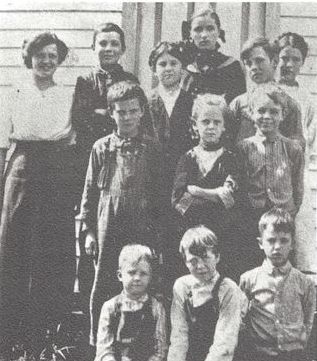 |
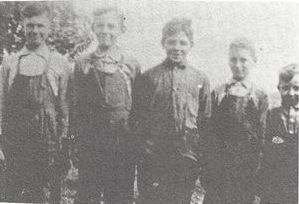 |
 |
|||||||||||||||||||||||||
| Pupils at No. 1 school in 1914. Front row from left: Ira Stine, Loy Brooker, Ira Stine. Second row: Laborde, Crouch, Bill Stine. Third row: Teacher, Minnie Reves, Carl Reves, Lois Crouch (deceased), Irene Brooker Brubaker, Revere Brooker, Mary Reves Faber. | No. 2 school children: Leo Klockentager, Malford Kinney, Mrle Kinney, Ralph West, Clark Kinney. | (Front row) Pansy Moss, Orvilla West (sitting on Ruth Ogden's lap), O.C. Guernsey. (Back row) Lois Moss, Evelyn Elder, Clara Huffman, Lois Klockentager, Beulah Guernsey. | |||||||||||||||||||||||||
| School No. 2 This was called the Murphy school and in later years the Ellis school. It was located on a high piece of ground about 1/2 mile west of where Leo Ellis lives today. Fred Ellis, Charles Mills, Lundy Todd and William Marriott were some of the directors. Some teachers were: 1909, Laura Shirley 1911, Lizzie Manders 1914, Mary Long (boarded at Lundy Todd home) 1915 Mattie Roberts, Perry, (boarded at Lundy Todd home) 1915-1917, Mr. Loving, Perry, (boarded at Jess Klockentager home) 1917-1918, Merle Thornburg Linsley, Perry, (boarded at Lundy Todd home) 1918-1920, Ruth Ogden, Perry, (boarded at Jess Kockentager home) 1920-1921, Marie Weddle, Minburn, was the last teacher of the Murphy School. Eventually Harry Elder bought the building, moved it down the hill, across the river on the ice - it was too big to go across the bridge. This is the white house at the bottom of the east hill today. During the summer of 1848, John Bivens, an unmarried man, made a claim in the northeastern corner of the township on the east side of the river. (This is thought to have been the Myers land where John Ross and Scott Shirley farm today) History records the first school in Washington Township as being in this area in 1857 with John Warford as the teacher, either in a house or an unused building nearby. In 1861 an acre of land was set aside for a school building which was established across the road west from where Bob Stout lives now. It was called the Myers school and in later years "Mayflower". In 1889 Cree Voas Wicks started here at age 4, a little young, but her Aunt Mattie Bryant, who lived where Nichols do now, was the teacher and as it was her last year, she wanted to get her "little niece started". Mattie Warford Bryant was a relative of the "first" teacher, John Warford. Cree say there were four in her class to take 8th grade County Examinations, and this could very well have been the first time such exams were required. The questions were mailed to the school, then the teacher, Ethan Ish, asked another teacher to come in and give the tests. This was so there could be no cheating of any kind between the students or any kind between the students or any partiality shown by the teacher. In later years, this procedure was changed and the 8th grade graduating students had to go to Adel to take the "Two Day Written" County Exams. One studied and crammed and worried about these exams almost from the very day he started school. I don't believe even the stiff college entrance tests of today are as worrisome as those 8th grade county exams the country kids were required to take. (City schools did not require them, neither did the consolidated schools) Henry West, today of Minburn, and a rural mail carrier in Washington Township for 42 1/2 years, also graduated from 8th grade from this school. |
|||||||||||||||||||||||||||
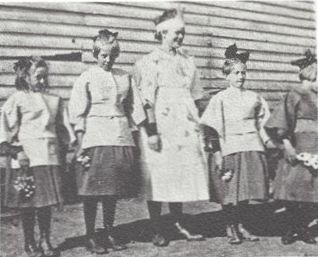 |
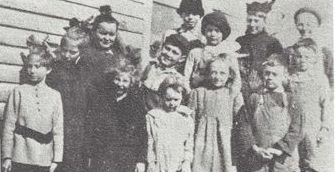 |
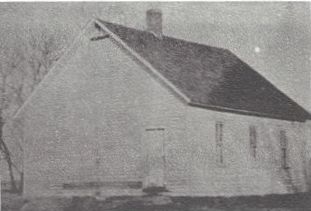 |
|||||||||||||||||||||||||
| After the Operetta, from left: Mae Voas, Irene Gottschalk Munson (deceased), Pauline Gottschalk Mortimer, Mildred Gottschalk Knowles, Marie Gottschalk Robinson. | From left: Mildred Gottschalk Knowles, Irene Gottschalk Mortimer, Thelma Byrant Hammond, Marie Gottschalk Robinson, Frances Lantz, Mae Voas, Scott Shirley, Don Shirley (stocking cap), Marlo Bryant (deceased), Bernard Lantz, Harry Gottschalk, Manuel Gottschalk | Mr. Thompson purchased the building in 1921 and moved it into Minburn where it is the P.O. Thompson home today. | |||||||||||||||||||||||||
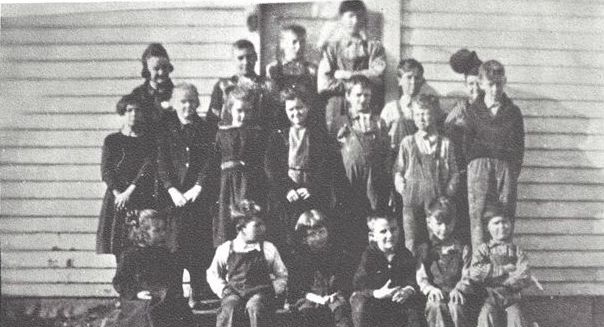 |
|||||||||||||||||||||||||||
| No. 4 students: Teacher Mary Kautsky
(Book today). Spring, 1921. Front row: Dorothy Conner, Oscar Conner, Lavon Pritchard, Jack Birchfield (deceased), Joe Kautzky, Amos Crellin. Second row: Cleo Shelley, Ida Alborn (Mrs. Roy Bodenburge), Agnes Alborn (Mrs. Charles Bock), Nona Crellin (Mrs. Paul Kautsky, deceased), Leslie Alborn (deceased), Max Pritchard and Rex Pritchard. Third row: Isabelle Alborn, Ted Book, Marvin Book, Paul Kautzky, Howard Spear, Tom Crellin. |
|||||||||||||||||||||||||||
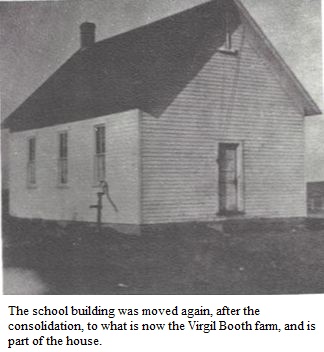 In
1858 the first Washington Township officers were elected at the
schoolhouse in school district No. 4. Therefore we know this was one of
the first schools, but can find no record of when it was built. It stood
on a knoll south of where Francis Andrews' house is today, because that
is where the road was then. In
1858 the first Washington Township officers were elected at the
schoolhouse in school district No. 4. Therefore we know this was one of
the first schools, but can find no record of when it was built. It stood
on a knoll south of where Francis Andrews' house is today, because that
is where the road was then.Eventually the road was made straight to Perry and the schoolhouse was moved 1/2 mile west on the northwest part of the corner (Fagen's field today). Charles Repp was the director in 1908, and Hayes Book in 1913. Some teachers were: Mary Wilcox Marie Kubetschek, 1908 Hattie Anderson, 1911 Bessie Spence, 1912 Mildred Book, 1913 Oakel Jordan from Waukee (roomed at the Patrick Graney farm, later became Mrs. John Graney) |
|||||||||||||||||||||||||||
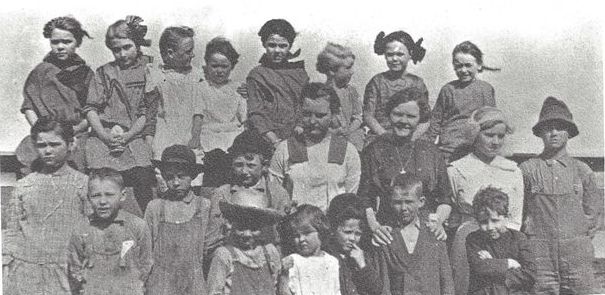 |
|||||||||||||||||||||||||||
| No. 5 school children sitting on the fence, front row from left: Grace Wilson, Paul Slaninger, Francis Slaninger, Francis Andrews (straw hat), Dorothy Ellis, Dale Ellis, Clifford Ellis, George McLellan, Jr. Middle row: (little boy) Frank Cannon, Florence Wilson, Mabel Harris, Ethel McLellan, Clarence Reynolds. Back row, left side: Mary Andrews, Hazel McLellan, Velma Bailey, Edna Bailey, Anna Andrews (deceased), Thelma McLellan, Opal Ellis, Thelma Bailey. | |||||||||||||||||||||||||||
Before there was any
school building in this district, Frank Slaniger told of going to school
in a building at the end of the chicken house. As he studied he could
hear the chickens clucking and crowing and look through the door and
watch them. The teacher was a Jolley from Adel.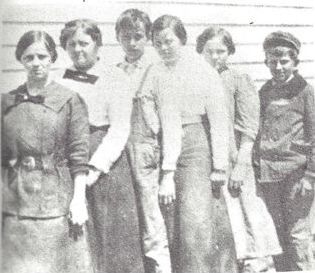 No. 5 school: Ethel McLellan, Marie Harris, Ed Slaninger, Helen Selsor, Marie Brenton, Joe Slaninger |
The first school
building was built on the northeast part of the corner. At the time of
the consolidation it was moved down by the bus sheds and was used many
years as a "shop". In 1968 it was moved to Harold Blauth's and made into
a garage. Thomas Harrison, George McLellan, Ira Andrews and Harry Ellis were some of the directors. Some teachers were: Cora Belt Rosalie Newlin Blanche Russell Viola Buchanan Marie Harris Bever (who was a student there and also taught) No. 6 School No. 6 was located one mile north of Panther Store. In the early days Mr. Long and Bert Emmert were teachers here. Others were: Grace Taylor Ethel Waddell |
||||||||||||||||||||||||||
| "Buttermilk" Farlow - he used to
bring a half gallon of buttermilk to school each day, hang it in the
well to keep it cool, then make many trips back and forth all day long
to drink it. Bertha Sutherland Peal Reed, 1905 Laura Shirley, 1908-1909. She boarded with Oscar Harrison's when Ina was a baby. Miss Shirley married Harry Brewer and they are the parents of Bill and Junior Brewer of our community today. Lenora Brewer, 1913. Miss Brewer, sister of Harry Brewer, now 88 and living in Perry. She said "That was a bad winter - the roads were blocked for days at a time. I walked across the fences on snow drifts to get to the school before the children. Then, half frozen,I had to carry wood and coal and get the fire started. That was my last year teaching in country schools!" Some of the students she remembered were Ed and Clarrence Reiste, Earnest Bever, and Betzenhausers. Bessie Reiste, student at No. 9, also taught here in later years. Some of the directors were Milton Bever, Bert Reed and Martin Nissley. A tornado went through here in 1917, taking down trees and damaging the roof. After the consolidation the building was moved by John Knosby west of the new building where it was used for storage and later torn down. No. 7 "readin', 'riting' and 'rithmetic" at No. 7. Kate McCarthy was teaching at No. 7 her first year, and Dick Harrison, just a little fellow, was having difficulty with addition. Kate said "Now Dick, if you had one apple and I gave you two more, how many apples would you have?" He pondered this a moment, then suddenly brightened and answered, "Not any. I'd eat 'em, all!" This smart (?) little boy did grow up and was a director in this district for several years and if you look closely, you will see his name as R.W. Harrison on the cornerstone of the Consolidated school as a board member in 1921. The teacher, Kate McCarthy, married George Glass, and they have lived in the township ever since, and celebrated their 59th Wedding Anniversary April 27, 1969.  Other teachers were: Nellie Hubbs Cleo Brissler Grace Hicklin Abbie Rose Inez Frantz Lena Scott in 1917 (now Mrs. Henry West of Minburn) May Beall The building was moved to the Dallas Bailey farm and made into a garage. School No. 8 No. 8 school was 2 miles west of Washington Center on the southeast corner. Some of the directors were U.S. Carris, Dan Crowley. Teachers were: 1908, Ollie Collins 1911, Ruth Thornburg 1913, Rosalia Newlin 1914, Elizabeth Brissler Mattie Roberts 1917, Angeline Carris |
|||||||||||||||||||||||||||
 |
|||||||||||||||||||||||||||
| No. 8, First row: Teacher, Elizabeth Tribey, Clara Repp, Omar Carris, Keith Purviance, Paul Purviance, George Repp. Second row: June Repp, Sarah Repp, Eleanor Crowley. | |||||||||||||||||||||||||||
| The building east moved to the Ed
Smith farm where it was made into the house. No. 9 No. 9 school district was in section 6, although it is not pictured on the map. A few of the directors were Fred Spintig, George Rausch, Fred Bock, and Carl Fey. Some teachers were: Mary Dowling, 1908 Marie Cummings Daisy Harding Clara Stump Margaret Thompson Coral Pricer, Perry, 1914-15 Myrtle James Nellie Fry Hazel Repp (Mrs. Rex Purviance) Some students attending were Carl Fey and his six sisters, James and Mary Hood, Charles and Elizabeth Bock, Henry Brissler and several children of the Belt family. All the one-room school houses were built to the same pattern. This one also went to the Ed Smith farm. A family by the name of Ogden was living there then and the house burned down. The teachers often went home after school with one of the pupils for a visit and to stay for supper. Many times they would even stay all night and all go to school together in the morning. Some school problems then. In 1884 a big controversy developed over the moving of a schoolhouse from its place in the field to what "some" thought was a better place along the road. One child might live close to a school but still have to walk more than a mile to the one in his own district and therefore be unhappy. Any changes made would be sure to cause talk and make someone else unhappy and then they would want to change. In 1908 a few of the 9 teachers received $34.00 and others received $40.00 per month. This was for doing their own "janitor" work as well as teaching all grades from first through the eighth. By 1920 the salary had increased to $87.00 per month and they were still doing their own janitor work! |
|||||||||||||||||||||||||||
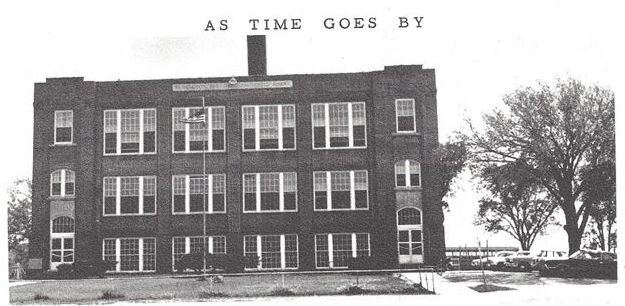 |
|||||||||||||||||||||||||||
| On March 8, 1920, five men were
elected to act as a building committee for a consolidation of the 9
independent school districts in Washington Township. Plans were published, bonds sold, and Proudfoot, Bird and Rawson contractors started the new building on the corner site purchased from A.J Slaninger for $2,250. School started a month late that fall, as the building was not completed, and was held on Saturday for 10 weeks to make up for the lost time. The first Superintendent was O.L. Morgan. The board had moved the No. 1 schoolhouse to the Center Corner and remodeled it into a home for him. It was wired for electricity from the Delco system at the new school. The Delco system consisted of 2 Engines and a set of 56 batteries, and the building for such was along the east side of the boiler room. Some of the first teachers were: Ida Daniels, hired to teach music "along with" 5th and 6th grades; Mary Jane Harrison hired to teach domestic science "along with" 3rd and 4th grades; Eunice Morgan, hired to teach Primary. J.C. Macy was the custodian. |
|||||||||||||||||||||||||||
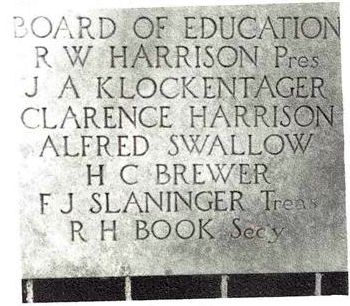 |
 |
||||||||||||||||||||||||||
| The cornerstone of the Washington Consolidated school with the names of those on the Board of Education in 1921. Behind this cornerstone are sealed some old records, pictures and newspapers to be left until the building is torn down at some future date. (Names on cornerstone: R.W. Harrrison, Pres.; J.A. Klockentager, Clarence Harrison, Alfred Swallow, H.C. Brewer, F.J. Slaninger, Treas.; R.H. Book, Sec'y) | First graduating class from the Consolidated School in 1923: Lillie Todd (Mrs. George Repp), John Spear, and June Repp (Mrs. Joe Summerson) | ||||||||||||||||||||||||||
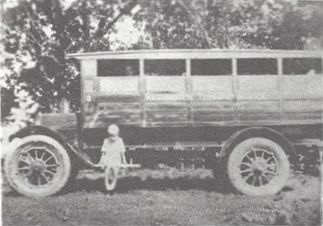 |
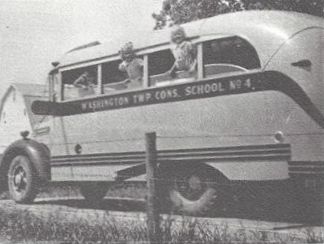 |
||||||||||||||||||||||||||
| One of the first school
buses. L.V. Wilkerson is driving, and his son, Willard is on the running board. |
The new buses, fall of 1939. Margaret, Marilyn and Marjorie Hill. | ||||||||||||||||||||||||||
| The first year they had six
schoolbuses, three Rios and three "Oles" (Oldsmobiles). Bus drivers
were: L.V. Wilkerson, Clarence Bailey, Keith Purviance, R.W. Harrison,
Dallas Bailey, and Herman Huffman, also hired as the mechanic to look
after all buses. No. 7, a little Ford bus, was added the next year, with
Earl McMullin the driver. It was cold weather and the buses did not have heaters, but it was decided "No the bus drivers need not furnish robes!" Several changes were made in truck chassis, but they kept the same old Matthews bus bodies which had been purchased in 1921 at $525.00 each. They had been bolted, wired, patched and fixed over and over again, but they still squeaked and swayed and bumped along to "nary an accident". |
|||||||||||||||||||||||||||
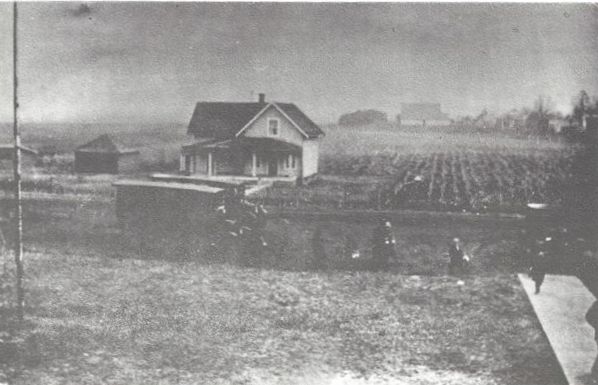 |
|||||||||||||||||||||||||||
| Unloading, 1921: car belongs to Ida Daniels. | |||||||||||||||||||||||||||
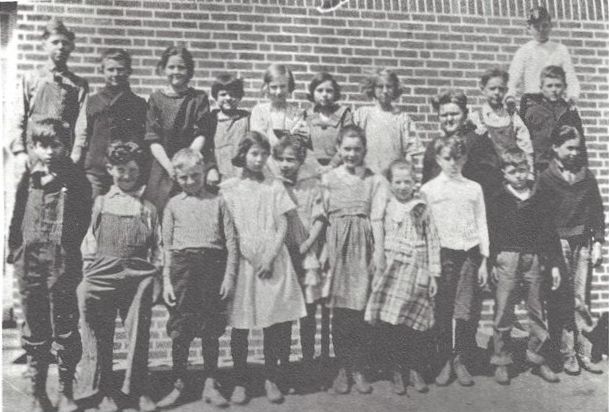 |
|||||||||||||||||||||||||||
| 4th and 5th grade class from Washington Consolidated in 1922-23. First row, from left: Ernest Slaninger, Clay McLellan, Howard Harrison, Virgie Daniels, Vivian Phillips, Kathrine Glass, Evelyn Miller, Harold Huffman, Amos Crellin, Virgil Harrison. Second row: Jesse Daniels, Lovell Diddy, Mabel Andrews, O.C. Guernsey, Maxine Taylor, Orvilla West, Thelma McLellan, Earl Carris, Joe Kautzky, Loren Diddy, Harry Huffman, standing (deceased). | |||||||||||||||||||||||||||
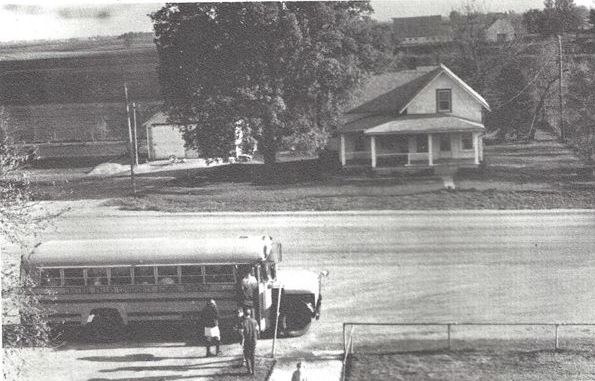 |
|||||||||||||||||||||||||||
| Unloading 48 years later in May of 1969. | |||||||||||||||||||||||||||
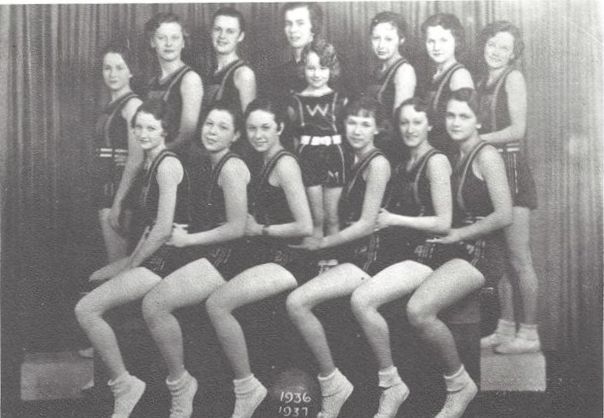 |
|||||||||||||||||||||||||||
| Back row, from left: Evelyn Huff, Betty Bailey, Ruth Andrews, Miss Brooks, Wilma Daniels, Dorothy Huff, Marvel Stine. Front row: Fae Fagen, Evelyn Huffman, Emalie Carico, Lois Peters, mascot, Doris Merryman, Virginia Simpson, Jessie Messamer. | |||||||||||||||||||||||||||
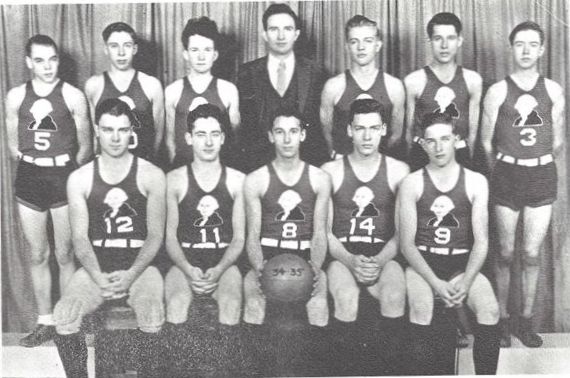 |
|||||||||||||||||||||||||||
| Back row: Harold Bailey, Harry Wicks, Howard Huff, Lovell Diddy, coach; Harold Snyder, Merle Faber, Reece Merryman. Front row: Ray Stine, Garold McMullin, Melvin Peddicord, John Glass, Floyd Meacham. | |||||||||||||||||||||||||||
| 1942. "Ouch! That piece was still hot." "It doesn't look very smooth, but I bet it will hold." "I smell rags burning, somebody's got hot sparks in his pants cuffs." "Who borrowed my hammer?" "Can you run the big saw?" These were common remarks heard at "The Shop" classes at Washington Twp. School during the hectic farming days of World War II. Backed by an energetic superintendent of schools, a co-operative board of education, and a vocation agriculture teacher who happened to wander into the scene, "The Shop" became a beehive of activity. Board of Education members were Pearl West, Wayne Book, E. Howard Hill, Paul Kautzky and Galen Stine. Ernest Bever was the secretary and Carl Fey the treasurer. K.T. Hancer was the superintendent, and E.J. Wilms the ag. teacher. |
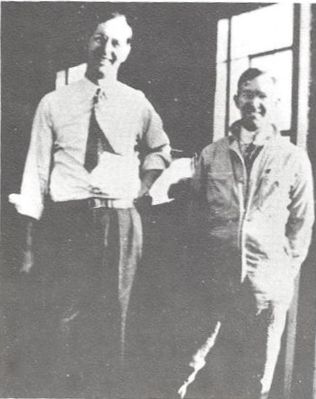 K.T. Hancer, Supt., and Elmer Wilms, the vocational agriculture teacher. |
||||||||||||||||||||||||||
| Farm wives
often wondered about the activities they were told were going on at the
shop, but when they saw some of the results coming from the place, they
soon became convinced. Farmers built or repaired hay and feed bunks,
portable hog houses, brooder houses, self feeders, hay racks, wagon
hoists ----. Tractors were overhauled and repaired. Combines and all
other forms of machinery were made as good as new again. Even older cars
were converted to run-about pickups. 77 flaretop wagon boxes were built.
Remember? The Flare-top was a wagon box designed to fit a standard wagon
running gear and still hold twice as much grain. About that time, the FFA Boys dragged into the shop some 3" pipe and made an odd looking contraption, something like a trailer with wheels set wide apart and on stilts, a barrel slung on the underside in the center for a tank, and long arms sticking out each side. This peculiar looking machine could be seen going down many Washington Twp. roads being towed behind the Ag Teacher's 1940 Plymouth on its way to one of the farms where a brave farmer was about to try a new wonder chemical nicknamed 2-4-D. It was reported that if this stuff was sprayed on weeds, they would die. What an innovation in farming that would be, for it was only going to kill the weeds, but not hurt grass. Melvin Alborn had some cockleburrs in the corn and got up courage enough to take a chance with it. He later reported the stuff worked, for it killed 99.44% of the burrs. Paul Purviance thought he'd risk using it in his corn, at least 20 acres, for different purpose. This time it was to be tried on butterprint. For evidence of results, the tractor driver was persuaded to skip two rows across the field to see if the new-fangled stuff was doing any good. Paul's hired man later confessed that they'd never skip any more rows again. When pressed for his reasons, he remarked, "Paul made me go out into the field and pull the weeds by hand in those two rows we didn't spray." Roadsides, fence rows, ditches, and other fields were sprayed, and it was almost an assured certainty that by 1965 or 1970 there wouldn't or couldn't be a weed left. Ha!! In 1969 the farmer is still spraying and there are still weeds. Only the methods have changed - improved sprayers including airplane spraying, and newer and better products under new names come out each year. Some of the old weeds are still a problem and new ones have come along to take over where others have disappeared. Co-operation seemed to be the key word to the success of the classes. Day school students shared the shop with their dads, and adult students helped and showed each other how to do the things needed. Cooperation was almost a necessity when as many as 30 attended classes in a shop designed to accommodate about 15 or 18 students. by E.J. Wilms |
|||||||||||||||||||||||||||
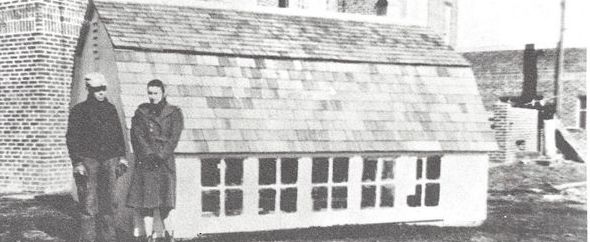 |
|||||||||||||||||||||||||||
| Guy Nourse and daughter Dorothy, with the brooder house they made. | |||||||||||||||||||||||||||
 |
|||||||||||||||||||||||||||
| Some of the flare wagon boxes made at the O.S.Y.A. shop classes -- note some are still using steel wheels. | |||||||||||||||||||||||||||
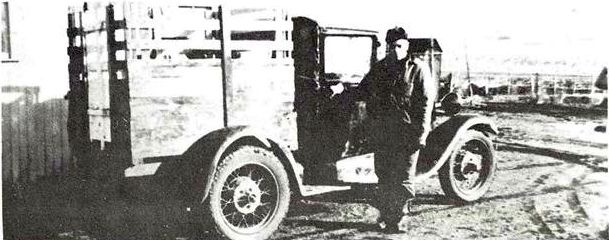 |
|||||||||||||||||||||||||||
| Harold Bailey and a pickup he made from a 1928 Model A Ford. | |||||||||||||||||||||||||||
| As early as 1952, the Superintendents from Washington and Minburn got together and worked out a schedule for combining on one or two subjects. This proved to be a very successful arrangement, and in 1958 the school districts were reorganized. | |||||||||||||||||||||||||||
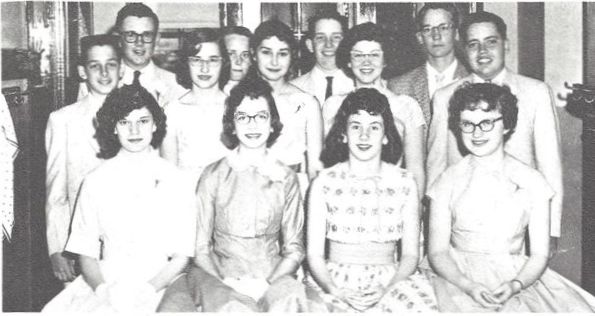 |
|||||||||||||||||||||||||||
| Thirteen boys and girls graduated from eight grade at Washington Township School in the spring of 1958. They are: Evelyn Crowley, Joyce Merryman, Jackie Ellis, Donna Wilkerson, Pat Ingram, Deanette Ritzman, Susan Susich, Shirley Smithson, Dick Wooldrige, Danny McMullen, Austin Woods, James Sears, Kent Baker. | |||||||||||||||||||||||||||
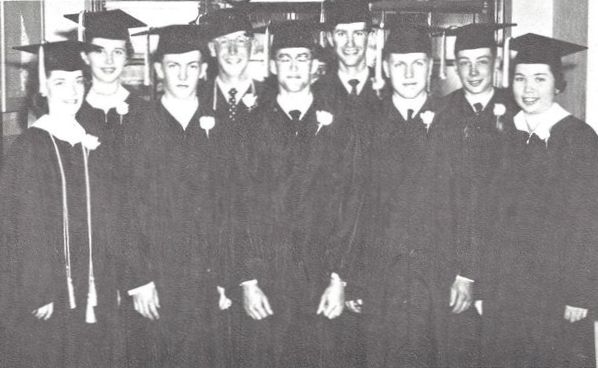 |
|||||||||||||||||||||||||||
| Pictured above are the graduates of Washington Township High School, class of 1958. They are: Judy Andrews, Bonnie Wicks, Ronnie Swartz, David Book, Loran York, Bill Liston, Roger Krueger, Lowell Morrison and Sandra Beasley (deceased). | |||||||||||||||||||||||||||
| Washington Township Parent Teacher Association | |||||||||||||||||||||||||||
| One of the finest organizations that
encompassed the entire community and did much to promote a fine
community spirit, cooperation, unity and understanding was the Washington Township Parent-Teacher Association organized in 1945. It was very active and flourished for many years. It was often observed and copied by other Parent-Teacher organizations. In its earliest years it did much to improve Parent-Teacher relationships as well as the school and the community. One of its first and probably greatest projects was to provide hot noon lunches for the students. The PTA purchased equipment for the project and raised the money by holding carnivals, presenting home talent plays and selling Christmas cards The organization was successful in its beginning years in attaining $1000 a year to be used for worthwhile and needy projects. The ladies of the community voluntarily planned menus, hired cooks, canned surplus vegetables from their gardens and helped in every possible way to make the hot lunch project a great success. One of the needs that was recognized and undertaken in the early years was the Kindergarten Round Up, which is being continued after 25 years from its origin. Other projects included a dental clinic for all students purchasing band instruments and uniforms, buying basketball suits and providing treats for the students at Christmas and at the last-day-of-school picnic, which was sponsored by the PTA. Each year a Reception was held for the Teachers of the Township School, in order to meet and honor those who did so much for our young people. The organization met once each month during the school year for an interesting and informative meeting. Great care was taken that each program would include both educational and entertaining features. The average attendance for the first two years reached the 200 mark. The first officers elected were President: Mrs. Gordon Stine, Secretary: Mrs. Ruth Nelson. Mr. K.T. Hancer was Superintendent of the School at that time. Mrs. Gordon Stine later serve3d as Vice-president of the Fifth District of the Iowa Parent-Teacher Association. The three pr4esidents to follow Mrs. Stine were Mr. Elmer Wilms, Mrs. William Stine and Mrs. Leonard James. The Washington Township Parent-Teacher Association reached into every home and successfully attained many outstanding goals, but as time passed, interest lagged and the PTA was dissolved. by Mrs. Gordon Stine |
|||||||||||||||||||||||||||
| Washington Township Farm Bureau | |||||||||||||||||||||||||||
| It was 1918. The United States had
entered the first World War. Everywhere, farmers were asked to produce
more food and fibre to feed and clothe a hungry world. The farmers of
Iowa and Dallas County, too, were challenged. So, in order to gain greater knowledge and to solve some of the problems that were prevalent, a group of progressive Dallas County farmers met in Dallas Center at the Opera House on January 26, 1918, and held the first organizational meeting of the Dallas County Farm Bureau. The first officers and Township Directors were elected at this meeting. Walter Shirley of Washington Township was chosen County Treasurer and Martin Niddly was the first Director from Washington Township. So the Township became a leader in the early days of Farm Bureau, and has continued that leadership throughout these many, many years. That same year (1918) 4-H Club work was introduced in Dallas County and each Farm Bureau Director organized a Pig Club in his township. Thus, Mr. Martin Nissly started the Boys 4-H Club in Washington Township. Early records show Ed Slaninger and William Stine leading a very active organization. When the girls 4-H work started, Mrs. Loren England became the first leader. Washington Township Farm Bureau began early to hold monthly meetings at various homes for its members. These meetings continue to be held, and are educational as well as social, and serve to keep members informed on many subjects. For many years, the Washington Township Resolutions Committee met to write a set of resolutions that were sent to the County Committee after being approved by the Township Farm Bureau members. Many of these resolutions were adopted by the County and State Resolutions Committees. One appeared in the late thirties that affected thousands of persons throughout the United States. It concerned rural mail delivery and asked that it be made to every farm home. This resolution appeared many times until it finally caught on and as a result, in 1959, the United States government made it possible for every rural home to receive mail at the gate, where there were two or more homes within the half mile. Through the years. Washington Township has furnished many leaders and outstanding leadership. Perhaps the most prominent of these was E. Howard Hill, who served as Iowa Farm Bureau Vice-president for four years, and President for sixteen, making twenty years when his excellent ideas and great influence was felt many times in the American Farm Bureau as well as the state organization. |
|||||||||||||||||||||||||||
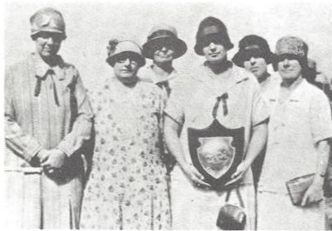 Farm Bureau Women, 1927. From left: Mrs. Lore England, Nell Harris, Mrs. Tom Stevens, Edith Huffman (holding plaque), Agnes Elder |
There have been four County Farm
Bureau presidents from Washington Township. Besides Howard Hill, they
were Pearl West, Gordon Stine and Robert West. Three from our Township have served as Dallas County Farm Bureau Women's Chairman. They were Mrs. Roy Snyder, Mrs. Ed Slaninger and Mrs. Gordon Stine. Mrs. Stine also served for eight years on the Iowa Farm Bureau Women's Committee. Washington Township Farm Bureau continue to serve the county and community in many worthwhile projects and strives to make this a better place to live through education, legislation and service. by Mrs. Gordon Stine |
||||||||||||||||||||||||||
| Washington Winners Boys 4-H Club | |||||||||||||||||||||||||||
| Boys 4-H Club work in Washington
Township originated sometime around the years 1918 and 1919, when Harry
Codlin was the county agent. In the case of the livestock clubs, all members regardless of the project that they were carrying on, were organized in local club groups under the direction of a local leader. One leader looked after all the livestock club members in his community. The clubs were: Baby beef Club, Market Litter Club, Market pig Club, Purebred sow and litter Club, Purebred gilt Club, Purebred heifer Club, Dairy Club, and Corn Club. Paul Purviance, Sr. was one of the early members of this group and one from the club who received as a reward for club work a free trip with the Dallas County group to Chicago in 1923 to National Boys and Girls Club Congress. The first banquet for all the clubs in the county was held in 1928 at the Christian Church in Adel. H.E. Codlin was still supervisor of the boys club work in the county. It was this year that the 4 leaf clover as the symbol of their organization was adopted, the 4 H's standing for Head, Heart, Hand and Health. It was agreed that 4-H Club work was decidedly worthwhile, and by using their hands and hearts and heads they would bring about changes that should mean much to the nation. In 1930 a Mr. Hall was Washington Twp. leader. That year large tents were used at the achievement show for exhibits in Adel where the boys and girls of Washington Twp. had a part in the county show, exhibiting 150 pigs, 20 baby beeves, 40 dairy and beef calves, 70 purebred gilts and sows, 30 lambs and 6 colts. In 1932 these boys were enrolled in a project known as a Pig Club: Bernard Brewer, Richard Keesey, Melvin Peddicord, Lloyd McLaughlin, Dale McLaughlin, Howard Huff, Clifford Capp, John Glass, and William Brewer. In 1944 Bob West was elected to the office of Vice President of the county organization. The same year in August at the achievement show Roderick Purviance exhibited the Champion Shorthorn Steer in his class and went on to win Grand Champion baby beef honors over all breeds. Nadine Purviance had Grand Champion Black Angus over all breeds in the years 1945, 1949 and 1950, at the Adel Achievement shows. In 1951 Gerald Diddy of the Club won the Grand Championship with a Black Angus baby beef. The following are some men of Washington Twp. who gave their time and efforts as leaders of the Club in the past. Clint Hickey, William Stine, Francis Andrews, Fred Brueck, Leonard James, Bob West, Stanley Weiser, Darrell Bever, Harry Stine. Some familiar names of club members in the past were Dean James, Junior Brewer, LaVern James, Gene Andrews, Jack West, John Stine, Larry Repp, Larry Taylor, Larry Bock, Lowell Peters, Raymond Repp, George Reiste, Max Royer, Carol James, Doris James, Harold Andrews, Larry Book, Raymond James, Marjorie, Marilyn and Margaret Hill. by Mrs. Paul Purviance The Club was dissolved in 1957, but reorganized in 1965 with Harry Stine as the leader and Raymond Repp assistant. Today the Club has 21 members from both Washington and Spring Valley Townships, and the leader is Raymond Repp with Kenneth Hykes as assistant. Projects are Beef, Swine, Horses, Sheep, Tractor, Crops, Chickens, Rabbits, Forestry and Arc Welding. During its 3 1/2 years the Washington Winners has shown reserve breed champions in individual and club groups, sent boys to 4-H camps, participated in Judging contests, has a county officer in its membership and is active in any other local and county activities. |
|||||||||||||||||||||||||||
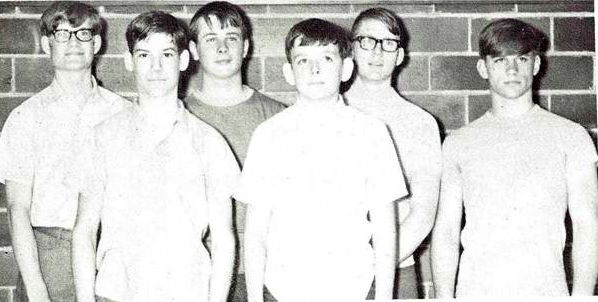 |
|||||||||||||||||||||||||||
| Boys 4-H Officers in 1969. Front row, Wayne Brewer, Treasurer; Greg Kautzky, Secretary; David Weiser, President. Second row: Tom Brewer, Co-Historian; Dennis King, Reporter; Paul Hillers, Vice-president. | |||||||||||||||||||||||||||
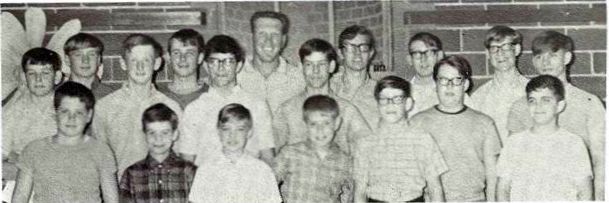 |
|||||||||||||||||||||||||||
| 4-H Group: Front row, from left: John Yost, Pat Andrews, Danny Reiste, Mark Yost, Donnie Brewer, Randy King, Jimmy Bever. Second row: Greg Kautzky, Leon Hillers, Ronnie Bever, Wayne Brewer. Back row: Dennis Weiser, Dennis King, Raymond Repp, leader: Mark Phillips, Paul Hillers, Tom Brewer, David Weiser. Absent when picture was taken were Larry Brewer, Mike Watts, Pat Watts, and Don Burgett. | |||||||||||||||||||||||||||
| HAWKEYE MAIDS IS OLDEST 4-H CLUB IN DALLAS COUNTY | |||||||||||||||||||||||||||
The Washington Township 4-H girls
club was organized by Mrs. Loren England in 1933. It was called the
"Go-Getters", signifying an "ambitious and active group". This was
certainly true, as a history of 36 years of worthwhile activities,
awards and community service has been recorded. The four young ladies pictured above were some of the charter members of the Washington Hawkeye Maids 4-H Club, attending one of the first meetings of the group. They are, left to right: Ruth McLaughlin Wicks, Wilma Capp McManus, Mrs. Loren England, Geneva Laverty, and Winifred Cap Liston. |
The present name was derived from
the name of the township (Washington), Iowa as the "Hawkeye" State, and
the members as "Maids" ready to serve. The group has lived up to the last phase of the 4-H pledge, "My Club, My Community, My Country, My World". Members have been elected to every county office and have been sent to camp every year. Their worthwhile projects have given many girls an opportunity to learn, to broaden their interests and develop their abilities, as well as having fun and fellowship in wholesome activities. All members, past and present, have been grateful to the leaders for their guidance, time, and effort spent in making this a successful club for the past 36 years. LEADERS Local women who have served as leaders are: Mrs. Loren England, Mrs. John Graney, Mrs. Roy Snyder, Mrs Pearl West, Mrs. Fred Meacham, Mrs. Paul Brooks, Mrs. K.T. Hancer, Mrs. Howard Hill (Silver Clover), Mrs. Tom Carlisle, Mrs. Wm. Stine, Mrs. M.P. Fitzgerald, Mrs. Darrell Bever, Mrs. Dean Bever, Mrs. Lester Halling, Mrs. R.C. Bacon, Mrs. George Repp, Mrs. Ernest Bever (in 1956 initiated as an Honorary member of the County Girls 4-H organization, also received the 4-H award of the Silver Clover in recognition of five years' leadership). |
||||||||||||||||||||||||||
| Also Mrs. Francis Slaninger (Silver
Clover), Mrs. Ronald Book, Mrs. Stanley Weiser, Mrs. Darrell Ritzman
(Silver Clover), Mrs. Gerald Taylor, Mrs. Lester Mitchell, Mrs. Paul
Janning, Mrs. Don Nissly, Mrs. Reese Merryman, and the present leaders,
Mrs. Archie Thompson and Mrs. Dale Halling. Leaders during 1948 and 1954 for the Washington Junior 4-H group were Mrs. Merlin Royer, Mrs. Oscar Connor, Mrs. Paul Kautzky, Mrs. Dean Miller, Mrs. Laurence Wirtz, Mrs. Francis Andrews and Mrs. Art Wicks. |
|||||||||||||||||||||||||||
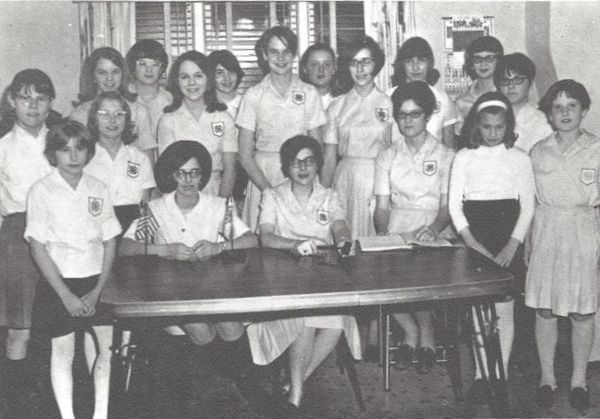 |
|||||||||||||||||||||||||||
| There were 19 members of Washington Hawkeye Maids 4-H club for the 1968 club year. They were, left to right, seated: Debbie Bever, vice-president; Christine Janning, president; Carolyn Ritzman, secretary. First row, standing: Carla Thompson, a historian, Julie Crowl, Mary Nissly, Bonnie Van Cleave, a historian; Karin Thompson, treasurer; Cindy Haldeman, Loris Buckley. Back row: Mary Beth Brewer, Mary Lynn Halling, reporter; Mary Beth Wilkerson, historian; Joy Weiser, Janice Gilmore, Susan Crowl, Virginia Janning, Peggy Nissly. Anne Stevens, a reporter, was absent when the picture was taken. | |||||||||||||||||||||||||||
| PROJECTS Club projects have included home improvement, clothing, food and nutrition, reading, entomology, personal accounts, small fruit, plant collection, photography, baby beef tree identification, beef carcass, dogs, and horses. |
|||||||||||||||||||||||||||
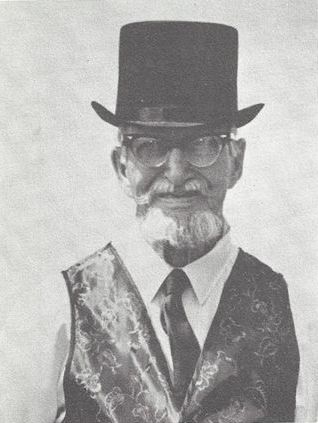 JENNIE KAUTZKY Jennie, the twin daughter of Joseph and Anna Slaninger, will be 95 in July of 1969. Another one of the oldest residents of Washington Township, she was born and grew up on the Tone Slaniger farm south and east of the Washington school. Her parents were both natives of Austria and came to Washington Township in 1867. They owned 372 acres of land known as the Center Stock Farm. Joseph passed away suddenly in 1875 of pneumonia, leaving his widow with twin daughters 10 months old, four other children and a farm to run, and she did it! In 1900 Jennie Slaninger married Edward Kautzky and moved 2 miles north and 1/2 mile west of the Washington Center corner onto the farm where she lived for 63 years. She has been living at the Lutheran Home in Perry for the last six years. They had four children, Ed, Jr. (deceased), Joseph, Mary (Mrs. Wayne Book) and Paul all living in the township today. She has 22 grandchildren and 60 great-grandchildren. |
FRANK HARRISON Frank Harrison, the oldest person living in Washington Township, was born here 94 years ago and never left! There are some others this old, born and raised here, but they have lived outside the township in later years. Frank's father, Edward, came here in his 27th year of life in 1866 with a party of 3 friends. He worked on a farm by the month, then bought 80 acres for $3.75 per acre. The following spring he walked to Muscatine and bought a team of mules and drove them back. With this team. a small house, and his will and determination he set out to break up his land and improve it. He was successful and 10 years later owned 640 acres. Frank, also a hard-working man like his father, is a solid citizen of strong Christian character, and still very active. He and his wife Gladys have three children, Edward and family living at Dallas Center, Jeanette, Mrs. Richard Reiste of Minburn, and Jean living at home, and 8 Grandchildren. 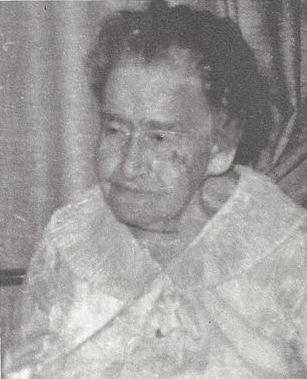 |
||||||||||||||||||||||||||
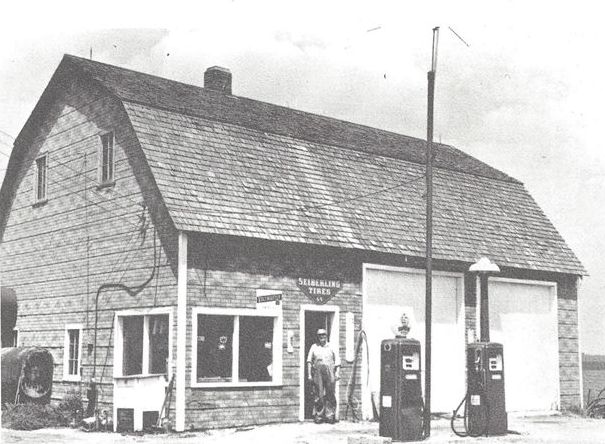 |
|||||||||||||||||||||||||||
| Panther Garage Ed Marlenee bought Panther Garage in 1937. It was a long narrow building at that time, and he built the building as it is today in 1941. As well as selling gas and oil, Ed does tire repair and welding of farm machinery. He has sold bottle gas for many years, which was used for cooking, in brooder stoves in the chicken houses, and later the pig houses. With his tank wagon Mr. Marlenee has supplied the farmers throughout the area with fuel oil, car gas and tractor gas, giving prompt and courteous service. Paul Slaughter had the first garage on this corner in 1918 and sold cars as well as gas and oil. Before that time Amos Royer had a blacksmith shop on the knoll north of the garage where he spent much of his time shoeing horses. Mr. Royer and his wife Sue came to Washington Township in 1875 and built the house where Delbert Bauer lives. The house looks much the same today, except the inside has been remodeled. CENSUS REPORTS In 1869 there were 86 dwellings in Washington Township with a total of 496 people.  In 1969 there are 130 houses with a population of 397. Washington Chapel Church of Christ The Washington Chapel Church of Christ was organized in 1866 at the Buchanan schoolhouse with 17 charter members. They were John and Margaret Strader, Noah Strader, Jeremiah and Catherine Reves A.J. Olin, Hannah Olin Jasper and Sarah Rice, Lemuel and Sarah Warford, A.C. Clark, Nancy Clark, Marilda Clark, Lettie Henderson, Mary Henderson and Thomas Hendersn. J.T. Bly was the organizing evangelist and lived one mile east of the church. Other ministers who have filled the pulpit: |
|||||||||||||||||||||||||||
|
|||||||||||||||||||||||||||
 |
|||||||||||||||||||||||||||
| The Chapel in later years. It was raised, making a basement for class rooms, and a furnace. | |||||||||||||||||||||||||||
| Earle Reves, a descendent of one of the charter members,
is Sunday School Superintendent and Max Harland of Perry is the
assistant. Mrs. Harold Wicks a relative of the early Clark family, is the organist. Mrs. Merle Faber is Superintendent of the grades, with Mrs. Max Harland as assistant. Between 75 and 100 are in attendance each Sunday for morning services, over a century since the first group of 17 dedicated Christians met to establish the church. |
|||||||||||||||||||||||||||
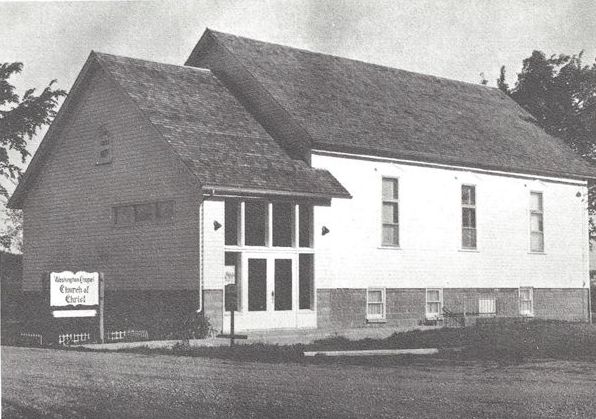 |
|||||||||||||||||||||||||||
| An Annex was added in the winter of 1960-61 and plans are in the making for another addition in the near future. | |||||||||||||||||||||||||||
| EVANGELIC CHURCH Another little country church was on the No. 9 road across from the school building. A German family by the name of Henry Fuchs owned the land and gave the corner for building in 1890. It was an Evangelic Church with German services held regularly, exchanging ministers with Pilot Mound. In later years when some of its founders moved away and it began to change to English, the attendance dwindled and in 1924 the building was torn down. The lumber was used in the barn and other buildings on the Charles Bock farm of today. |
|||||||||||||||||||||||||||
| METHODIST CHURCH | |||||||||||||||||||||||||||
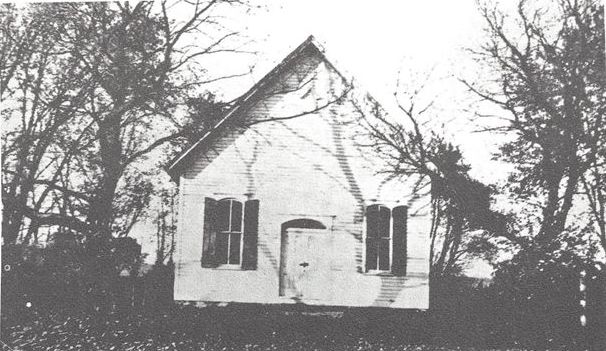 |
|||||||||||||||||||||||||||
| On December 28, 1876, the Rev. David
Shenton took up appointment in Washington Township at the Bever
schoolhouse. The organization at its commencement had a membership of
six. By 1879 plans for a building were in the making. John Bever donated
a piece of land one mile south of Washington Chapel on the northeast
corner, where this building was erected and the membership grew to 64. Some of the older members died, some moved away and others started attending Washington Chapel because of the large group of active young people. (Parents and grandparents of many of our members today.) The building was moved to a farm and used for storage for several years, but even that is gone now. Religion played a very important part in the lives of our early farmers. They worked six days, but the seventh was remembered as "The Lord's Day". They went to church in the morning, afternoon and again in the evening - some of them even walked! We owe much to the influence of these early Christians as we see their influence reflected in the lives of people in our community today, making the old hymn "Faith of Our Fathers" seem like a living memorial "specially for them" each time it is sung. |
|||||||||||||||||||||||||||